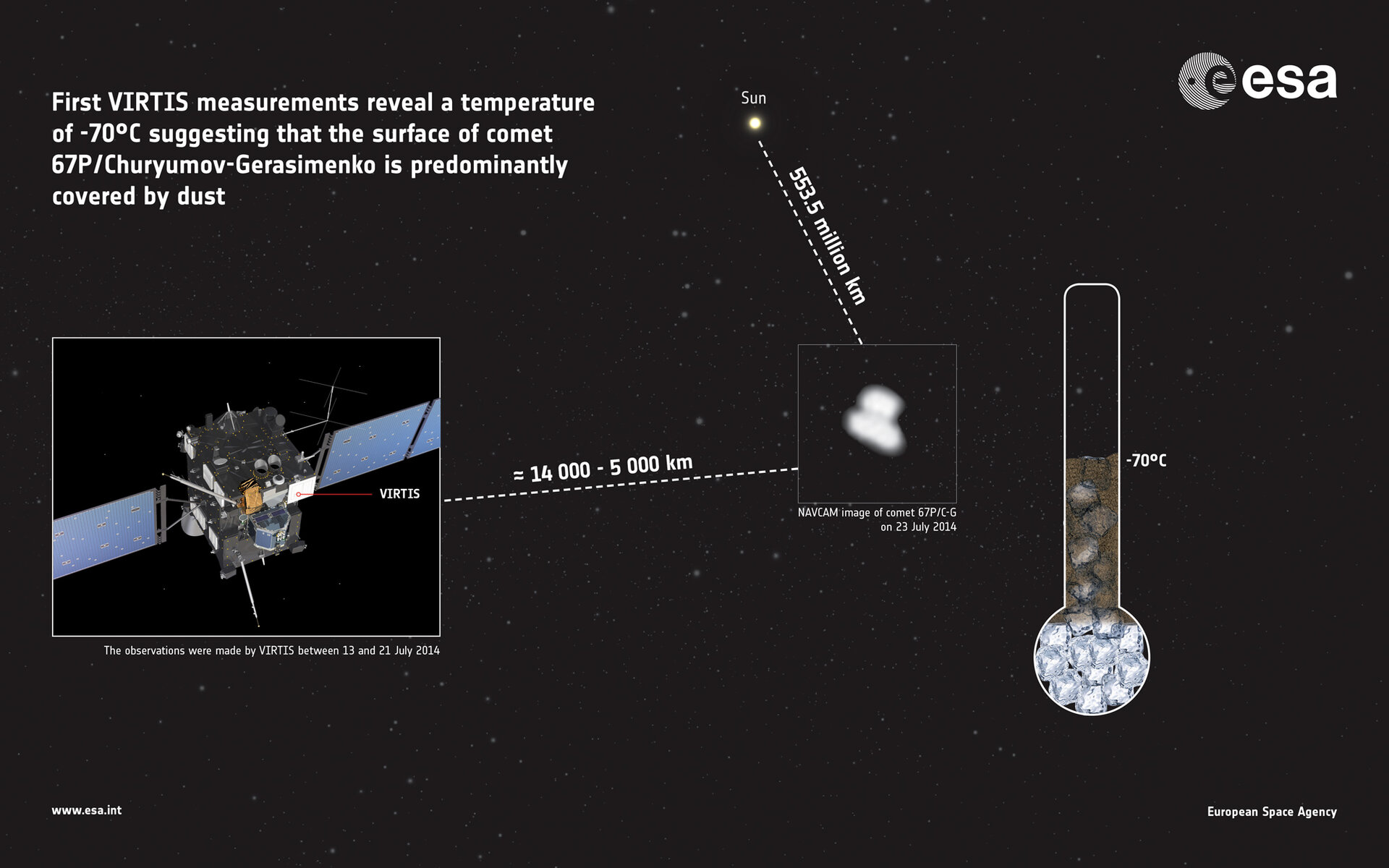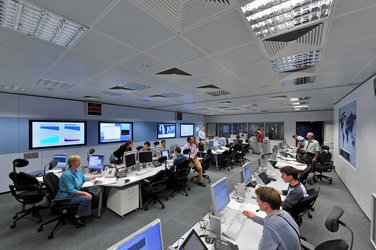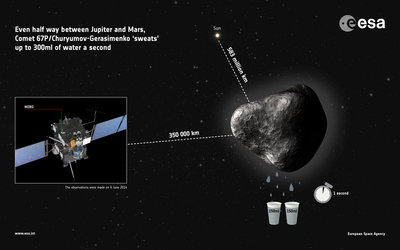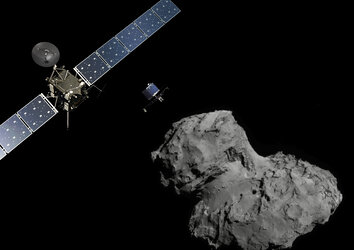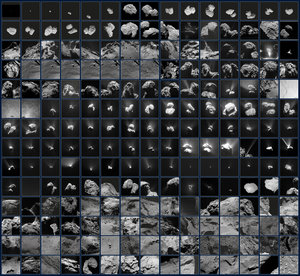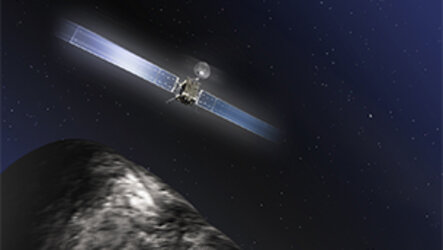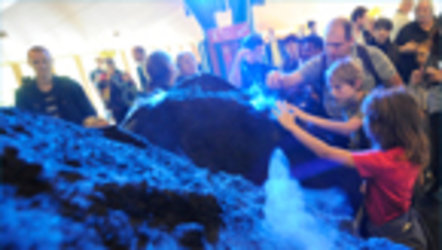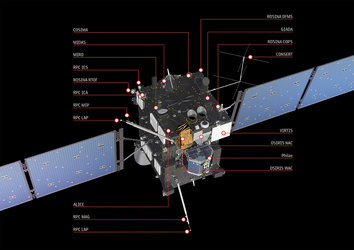Rosetta takes comet’s temperature
ESA’s Rosetta spacecraft has made its first temperature measurements of its target comet, finding that it is too hot to be covered in ice and must instead have a dark, dusty crust.
The observations of comet 67P/Churyumov–Gerasimenko were made by Rosetta’s visible, infrared and thermal imaging spectrometer, VIRTIS, between 13 and 21 July, when Rosetta closed in from 14 000 km to the comet to just over 5000 km.
At these distances, the comet covered only a few pixels in the field of view and so it was not possible to determine the temperatures of individual features. But, using the sensor to collect infrared light emitted by the whole comet, scientists determined that its average surface temperature is about –70ºC.
The comet was roughly 555 million kilometres from the Sun at the time – more than three times further away than Earth, meaning that sunlight is only about a tenth as bright.
Although –70ºC may seem rather cold, importantly, it is some 20–30ºC warmer than predicted for a comet at that distance covered exclusively in ice.
“This result is very interesting, since it gives us the first clues on the composition and physical properties of the comet’s surface,” says VIRTIS principal investigator Fabrizio Capaccioni from INAF-IAPS, Rome, Italy.
Indeed, other comets such as 1P/Halley are known to have very dark surfaces owing to a covering of dust, and Rosetta’s comet was already known to have a low reflectance from ground-based observations, excluding an entirely ‘clean’ icy surface.
The temperature measurements provide direct confirmation that much of the surface must be dusty, because darker material heats up and emits heat more readily than ice when it is exposed to sunlight.
“This doesn’t exclude the presence of patches of relatively clean ice, however, and very soon, VIRTIS will be able to start generating maps showing the temperature of individual features,” adds Dr Capaccioni.
In addition to global measurements, the sensor will study the variation of the daily surface temperature of specific areas of the comet, in order to understand how quickly the surface reacts to solar illumination.
In turn, this will provide insight into the thermal conductivity, density and porosity of the top tens of centimetres of the surface. This information will be important in selecting a target site for Rosetta’s lander, Philae.
It will also measure the changes in temperature as the comet flies closer to the Sun along its orbit, providing substantially more heating of the surface.
“Combined with observations from the other 10 science experiments on Rosetta and those on the lander, VIRTIS will provide a thorough description of the surface physical properties and the gases in the comet’s coma, watching as conditions change on a daily basis and as the comet loops around the Sun over the course of the next year,” says Matt Taylor, ESA’s Rosetta project scientist.
“With only a few days until we arrive at just 100 km distance from the comet, we are excited to start analysing this fascinating little world in more and more detail.”
More about Rosetta
Rosetta is an ESA mission with contributions from its member states and NASA. Rosetta’s Philae lander is provided by a consortium led by DLR, MPS, CNES and ASI. Rosetta will be the first mission in history to rendezvous with a comet, escort it as it orbits the Sun, and deploy a lander.
Comets are time capsules containing primitive material left over from the epoch when the Sun and its planets formed. By studying the gas, dust and structure of the nucleus and organic materials associated with the comet, via both remote and in-situ observations, the Rosetta mission should become the key to unlocking the history and evolution of our Solar System, as well as answering questions regarding the origin of Earth’s water and perhaps even life.
For more information, please contact:
Markus Bauer
ESA Science and Robotic Exploration Communication Officer
Tel: +31 71 565 6799
Mob: +31 61 594 3 954
Email: markus.bauer@esa.int
Matt Taylor
ESA Rosetta project scientist
Email: matthew.taylor@esa.int
Fabrizio Capaccioni
VIRTIS principal investigator
INAF-IAPS, Rome, Italy
Email: fabrizio.capaccioni@iaps.inaf.it















 Germany
Germany
 Austria
Austria
 Belgium
Belgium
 Denmark
Denmark
 Spain
Spain
 Estonia
Estonia
 Finland
Finland
 France
France
 Greece
Greece
 Hungary
Hungary
 Ireland
Ireland
 Italy
Italy
 Luxembourg
Luxembourg
 Norway
Norway
 The Netherlands
The Netherlands
 Poland
Poland
 Portugal
Portugal
 Czechia
Czechia
 Romania
Romania
 United Kingdom
United Kingdom
 Slovenia
Slovenia
 Sweden
Sweden
 Switzerland
Switzerland

























